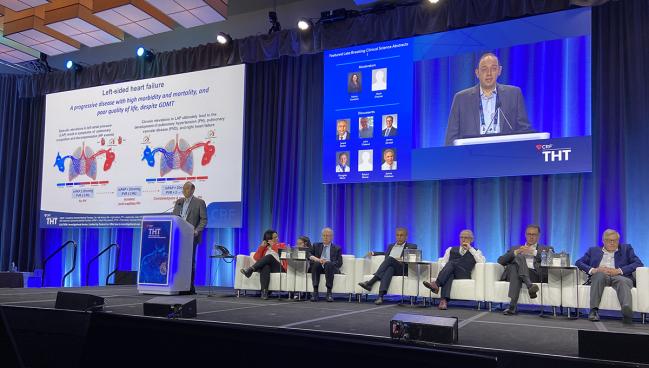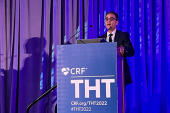Durable 1-Year Outcomes With Coronary Sinus Shunt for HF: ALT-FLOW EFS
The single-arm data inject hope in the field, but only a randomized, sham-controlled trial will define the shunt’s benefit.

BOSTON, MA—One-year outcomes from an early feasibility study (EFS) show durable improvements in symptoms and quality of life in symptomatic heart failure (HF) patients treated with a novel coronary sinus shunt, according to new data presented this week at THT 2024.
The ALT-FLOW EFS results, although promising, are still early in this field, with investigators saying it will take a randomized, sham-controlled trial before too much excitement can be attached to positive early findings from this or any trial. The only sham-controlled trial conducted in the space so far, REDUCE-LAP II, focused on patients with HF and preserved ejection fraction (HFpEF), was negative.
“The ALT-FLOW II trial is going to be the randomized trial,” Zahr told TCTMD. “We’re going to randomize 100 patients one-to-one to a sham procedure or to the therapy with the coronary sinus shunt. I think those results will be very telling.”
Development of these shunts is part of a new wave of device-based treatment for patients with chronic symptomatic HF. As Zahr explained, episodic increases in left atrial pressure lead to pulmonary congestion, which is a common mechanism for worsening symptoms and acute decompensation. Chronic elevations in left atrial pressure ultimately lead to pulmonary hypertension, pulmonary vascular disease, and right heart failure.
To combat this, multiple companies are developing devices/procedures to shunt blood from the left atrium to the right atrium to offload left atrial pressure. Most create a small atrial septal defect in the interatrial septum, with some using a small ring-like device to maintain the defect’s patency. The shunt size ranges from 4 mm to as large as 10 or 12 mm. Some trials are focused on patients with preserved ejection fraction, while others are targeting all patients with symptomatic HF. Some are using invasive hemodynamic tests to identify patients most likely to benefit, while others are relying on clinical symptoms.
The device tested in ALT-FLOW EFS, the Apture transcatheter shunt system (Edwards Lifesciences), doesn’t pass through the septum but instead creates a channel between the left atrium and coronary sinus. The aperture is maintained via a nitinol-based shunt, and this alternative approach allows for natural physiological flow from the left atrium to the coronary sinus and then into the right atrium. In this way, the interatrial septum is spared, which is important as it can be used for future transcatheter interventions, said Zahr.
“It does not disrupt the natural flow dynamics of the heart as well as makes it more difficult, hypothetically, to have a cerebrovascular event from a paradoxical stroke,” said Zahr, referring to embolization that may occur if blood is shunted from the right to left atrium.
The 6-month results were presented last year at THT 2023 and published simultaneously in JACC: Cardiovascular Interventions. In the 1-year follow-up of 71 patients presented at THT 2024, the improvements in NYHA functional class and health status assessed by the Kansas City Cardiomyopathy Questionnaire (KCCQ) were maintained, with 68% of patients in NYHA functional class I or II compared with 92% in NYHA functional class III at baseline. Additionally, there was a significant 27-point improvement in the KCCQ overall summary score, a benefit maintained from 6 months, and the 6-month reduction in PCWP when exercising at 20 watts was 5.7 mm Hg.
There were no adverse effects of mean indices of right heart hemodynamics, volumes, function, or right ventricle-pulmonary artery coupling with the procedure.
No Difference by PVR Status
Javed Butler, MD (Baylor Scott and White Health, Dallas, TX), a panelist during the discussion, questioned if there was any information from the small study that could identify patients who wouldn’t respond to treatment. “In the minority of patients who remained in New York Heart Association class III,” he asked, “was there any correlation with wedge pressure not going down as much, or any other characteristics that could guide us on who should be getting these devices?”
Zahr said those with the largest improvement in PCWP had the biggest gains in quality of life, but he cautioned that this single-arm trial was not blinded so those results need to be confirmed in a sham-controlled trial.
The improvements in functional class, quality of life, and wedge pressures were evident in all subgroups, including those with and without latent pulmonary vascular disease, said Zahr.
That’s a critical distinction in light of data from the only sham-controlled trial published to date. In REDUCE-LAP II, which failed to show any advantage of atrial shunting on HF events or health status, investigators did observe that those with pulmonary vascular resistance (PVR) < 1.7 Wood units, as well as those who did not have a pacemaker/implantable cardioverter-defibrillator (ICD), responded to the procedure. In ALT-FLOW II, there was no impact of pacemaker/ICD or PVR on outcomes.
“Those are small numbers and will need to be validated, but we did not see any negative signal so far, including in those with a PVR between 2 and 5 [Wood units],” said Zahr.
Medical therapy in HF has advanced a lot recently so the way I look at this is not that the shunt will replace medical therapy, but it may have benefits on top of it. Firas Zahr
To TCTMD, Zahr noted that roughly 27% of the patients were treated with SGLT2 inhibitors, a drug class that became available for HF halfway through the trial. “Unfortunately, a lot of these patients are still symptomatic,” he said. “They have few options. Medical therapy in HF has advanced a lot recently so the way I look at this is not that the shunt will replace medical therapy, but it may have benefits on top of it.”
In a separate THT session devoted to interatrial shunting, moderator Sheldon Litwin, MD (Medical University of South Carolina, Charleston), said that it’s relatively easy to enroll eligible patients into the early studies of interatrial shunting. Patients don’t want to take more medication, he said, but a mechanical fix to a mechanical problem makes sense to them.
Next month at the 2024 American College of Cardiology Scientific Session, William Abraham, MD (The Ohio State University Wexner Medical Center, Columbus), will present the results of the second sham-controlled trial—RELIEVE-HF—testing a 5.1-mm interatrial shunt (V-Wave) in HF patients with and without preserved ejection fraction.
Michael O’Riordan is the Managing Editor for TCTMD. He completed his undergraduate degrees at Queen’s University in Kingston, ON, and…
Read Full BioSources
Zahr F, on behalf of the ALT-FLOW EFS investigators. One year outcomes of left atrial to coronary sinus shunting for treatment of symptomatic heart failure: the ALT FLOW Early Feasibility Study one year results. Presented at THT 2024. March 5, 2024. Boston, MA.
Disclosures
- Zahr reports consulting fees/honoraria/speaker’s bureau fees from Edward Lifesciences and grant support/research contracts from Medtronic.





Comments